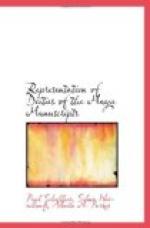5. An isolated figure, Dr. 50a (the sitting figure at the right). This wears the skull as head ornament, which is represented in exactly the same way as in the Aztec manuscripts (see Fig. 6).
6. Another isolated figure is twice represented combined with the death-god in Dr. 22c. This picture is so effaced that it is impossible to tell what it means. The hieroglyph represents a variant of the death’s-head, Cimi. It seems to signify an ape, which also in the pictures of the Mexican codices was sometimes used in relation to the death-god.
The symbols of the death-god are also found with the figure without a head on Dr. 2 (45)a, clearly the picture of a beheaded prisoner. Death symbols occur, too, with the curious picture of a hanged woman on Dr. 53b, a picture which is interesting from the fact that it recalls vividly a communication of Bishop Landa. Landa tells us, the Mayas believed that whoever hanged himself did not go to the underworld, but to “paradise,” and as a result of this belief, suicide by hanging was very common and was chosen on the slightest pretext. Such suicides were received in paradise by the goddess of the hanged, Ixtab. Ix is the feminine prefix; tab, taab, tabil mean, according to Perez’ Lexicon of the Maya Language, “cuerda destinada para algun uso exclusivo”. The name of this strange goddess is, therefore, the “Goddess of the Halter” or, as Landa says, “The Goddess of the Gallows”. Now compare Dr. 53. On the upper half of the page is the death-god represented with hand raised threateningly, on the lower half is seen the form of a woman suspended by a rope placed around her neck. The closed eye, the open mouth and the convulsively outspread fingers, show that she is dead, in fact, strangled. It is, in all probability, the goddess of the gallows and halter, Ixtab, the patroness of the hanged, who is pictured here in company with the death-god; or else it is a victim of this goddess, and page 53 of the manuscript very probably refers, therefore (even though the two halves do not belong directly together), to the mythologic conceptions of death and the lower regions to which Landa alludes.
7. Lastly the owl is to be mentioned as belonging to the death-god, which, strange to say, is represented nowhere in the pictures realistically and so that it can be recognized, although other mythologic animals, as the dog or the moan bird, occur plainly as animals in the pictures. On the other hand, the owl’s head appears on a human body in the Dresden manuscript as a substitute for the death-deity itself, for example on Dr. 18c, 19c, 20a and 20c and elsewhere, and forms a regular attendant hieroglyph of the death-god in the group of three signs already mentioned (Fig. 5).
Among the antiquities from the Maya region of Central America, there are many objects and representations, which have reference to the cultus of the death-god, and show resemblances to the pictures of the manuscripts. The death-god also plays a role, even today, in the popular superstitions of the natives of Yucatan, as a kind of spectre that prowls around the houses of the sick. His name is Yum Cimil, the lord of death.




